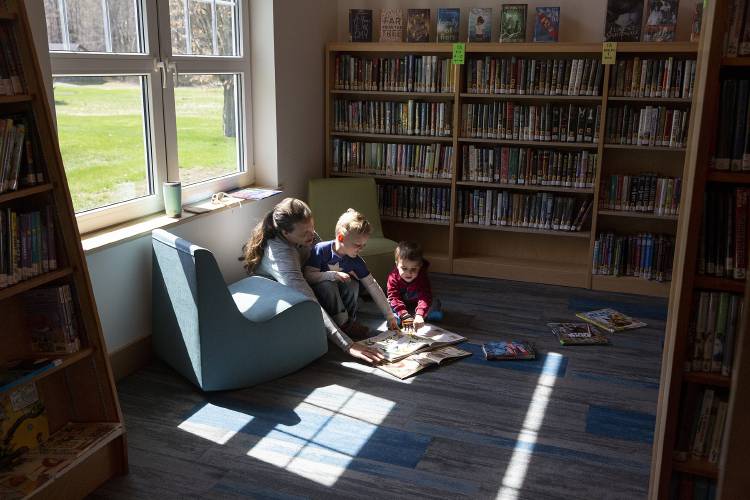Editorial: Reading stats distressing

From left, Jenny Ramsey, of Meriden, N.H., reads a book with her son Andrew Ramsey, 4, and his friend Rowen Griffin, 3, of Plainfield, N.H., at the Meriden Library on Friday, April 21, 2023. Ramsey said her family had missed the community space since the old library building was demolished in October 2021. “What we really like about the Meriden Library is that we can walk from our house,” she said. (Valley News / Report For America - Alex Driehaus) Copyright Valley News. May not be reprinted or used online without permission. Send requests to permission@vnews.com. Alex Driehaus
| Published: 10-24-2023 3:02 PM |
What if America’s culture warriors no longer felt the need to ban the books they hate — because no one was capable of reading them anyway?
This depressing, dystopian and rhetorical question is prompted by recent news reports about the decline in reading proficiency among schoolchildren in Vermont and New Hampshire.
According to VtDigger, reading scores on standardized tests have been in decline since 2015 in the Green Mountain State. By last year, 71% of eighth-graders tested in Vermont scored below the “proficient” level, up from 60% two decades ago. Among fourth-graders: 68% failed to achieve proficiency in 2022, up from 61% 20 years earlier. (Note that the scores in the baseline year of 2002 weren’t all that good to begin with.)
In New Hampshire, whereas 54% of third-graders scored well enough to be deemed proficient in reading in 2018, only 45% did just four years later, according to the New Hampshire Bulletin.
The declines in both states mirror national trends, and no doubt were exacerbated by educational restrictions imposed by the pandemic. And standardized test scores do not pronounce the final word on a child’s ability to read. But the growing concern among literacy advocates is more than justified.
Article continues after...
Yesterday's Most Read Articles
Encouragingly, a consensus seems to be emerging about how to reverse this trend: Ditch the “balanced literacy” approach to teaching reading that has been ascendant in schools for at least a generation, and return to the structured phonics-based instruction by which many former children who are now senior citizens learned to read.
To oversimplify a complicated issue, in the balanced literacy method, children are told to use context clues when they encounter words they don’t recognize, basically guessing at them on the basis of whether the word looks and sounds right, and makes sense in the sentence. This contrasts with phonics, in which children do sequenced exercises in sounding out consonants and vowels until they recognize the word.
Research has long supported phonics, combined with rigorous texts that build vocabulary and depth of comprehension, as the preferred approach, but recent advances in brain science have sealed the deal for what’s called “the science of reading,” according to advocates. The New York Times summarizes in this fashion: “In fact, functional magnetic resonance imaging of the brain demonstrates that humans process written language letter by letter, sound by sound. Far from being automatic, reading requires a rewiring of the brain, which is primed by evolution to recognize faces, not words.”
That phonics has carried the day may be inferred from the fact that the high priestess of balanced literacy, Professor Lucy Calkins of Columbia University’s Teachers College, has revised her widely used K-2 reading curriculum to include “for the first time, daily structured phonics lessons to be used with the whole class,” the Times reported last year.
Advocates for the “science of reading” in Vermont are pressing home their advantage by urging that Gov. Phil Scott appoint a new education commissioner with expertise in reading instruction, one “who understands the opportunity that we have right now in Vermont to turn the reading crisis around for our kids,” in the words of one reading specialist.
A bill pending in the New Hampshire Legislature would require all public school districts to adopt measurable, evidence-based literacy instruction in grades K-5 that emphasizes a phonics-based approach and the five components of reading established by a national panel in 2000: phonemic awareness, phonics, reading fluency, vocabulary and text comprehension. In this, New Hampshire would joint 30 other states and the District of Columbia that have passed legislation or implemented policies on science-based methods for teaching reading, most of them since 2019.
This is all to the good, but we doubt that a curriculum change alone can produce the reading revolution that the nation requires. The distractions provided by unlimited use of the digital screens of all kinds that are ubiquitous among young people militate against reading comprehension and fluidity. And busy parents who cannot, or do not, take the time to read to their young children or discuss their own reading with their older children will make it harder to restore the nation to the desired level of literacy.
The negative consequences for individual children of the inability to read well have long been known. They include poverty, poor health and incarceration. But a nation of poor readers also poses a threat to democracy. The ability to read and comprehend and the willingness to do so are essential to wisely exercising the right to vote.

 Editorial: Dartmouth lets protesters know where they stand
Editorial: Dartmouth lets protesters know where they stand Editorial: Response to campus protests only adds fuel to the fire
Editorial: Response to campus protests only adds fuel to the fire Editorial: Chris Sununu’s moral vacuum
Editorial: Chris Sununu’s moral vacuum Editorial: Gambling tarnishes America’s sporting life
Editorial: Gambling tarnishes America’s sporting life
